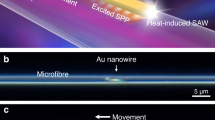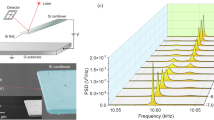Abstract
Directed-assembly of nanowire-based devices1 will enable the development of integrated circuits with new functions that extend well beyond mainstream digital logic. For example, nanoelectromechanical resonators are very attractive for chip-based sensor arrays2 because of their potential for ultrasensitive mass detection3,4,5,6. In this letter, we introduce a new bottom-up assembly method to fabricate large-area nanoelectromechanical arrays each having over 2,000 single-nanowire resonators. The nanowires are synthesized and chemically functionalized before they are integrated onto a silicon chip at predetermined locations. Peptide nucleic acid probe molecules attached to the nanowires before assembly maintain their binding selectivity and recognize complementary oligonucleotide targets once the resonator array is assembled. The two types of cantilevered resonators we integrated here using silicon and rhodium nanowires had Q-factors of ∼4,500 and ∼1,150, respectively, in vacuum. Taken together, these results show that bottom-up nanowire assembly can offer a practical alternative to top-down fabrication for sensitive chip-based detection.
This is a preview of subscription content, access via your institution
Access options
Subscribe to this journal
Receive 12 print issues and online access
$259.00 per year
only $21.58 per issue
Buy this article
- Purchase on Springer Link
- Instant access to full article PDF
Prices may be subject to local taxes which are calculated during checkout




Similar content being viewed by others
References
Lieber, C. M. & Wang, Z. L. Functional nanowires. MRS Bull. 32, 99–108 (2007).
Zheng, G. F. et al. Multiplexed electrical detection of cancer markers with nanowire sensor arrays. Nature Biotechnol. 23, 1294–1301 (2005).
Li, M., Tang, H. X. & Roukes, M. L. Ultra-sensitive NEMS-based cantilevers for sensing, scanned probe, and very high-frequency applications. Nature Nanotech. 2, 114–120 (2007).
Yang, Y. T., Callegari, C., Feng, X. L., Ekinci, K. L. & Roukes, M. L. Zeptogram-scale nanomechanical mass sensing. Nano Lett. 6, 583–586 (2006).
Craighead, H. G. Nanoelectromechanical systems. Science 290, 1532–1535 (2000).
Lavrik, N. V., Sepaniak M. J. & Datskos, P. G. Cantilever transducers as a platform for chemical and biological sensors. Rev. Sci. Instrum. 75, 2229–2253 (2004).
Wang, Y. et al. Use of phosphine as an n-type dopant source for vapor–liquid–solid growth of silicon nanowires. Nano Lett. 5, 2139–2143 (2005).
Tian, M. et al. Electrochemical growth of single-crystal metal nanowires via a two-dimensional nucleation and growth mechanism. Nano Lett. 3, 919–923 (2003).
Keating, C. D. & Natan, M. J. Striped metal nanowires as building blocks and optical tags. Adv. Mater. 15, 451–454 (2003).
Xia, Y. et al. One-dimensional nanostructures: synthesis, characterization, and applications. Adv. Mater. 15, 353–389 (2003).
Smith, P. A. et al. Electric-field assisted assembly and alignment of metallic nanowires. Appl. Phys. Lett. 77, 1399–1401 (2000).
Huang, Y., Duan, X., Wei, Q. & Lieber C. M. Directed assembly of one-dimensional nanostructures into functional networks. Science 26, 630–633 (2001).
Whang, D., Jin, S., Wu, Y. & Lieber C. M. Large-scale hierarchial organization of nanowire arrays for integrated nanosystems. Nano Lett. 3, 1255–1259 (2003).
Huang, J., Fan, R., Connor, S. & Yang, P. One-step patterning of aligned nanowire arrays by programmed dip coating, Angew. Chem. Int. Edn 46, 2414–2417 (2007).
Liu, M. et al. Self-assembled magnetic nanowire arrays. Appl. Phys. Lett. 90, 103105 (2007).
Yin Y. et al. Template-assisted self-assembly: A practical route to complex aggregates of monodispersed colloids with well-defined sized, shapes, and structures. J. Am. Chem. Soc. 123, 8718–8729 (2001).
Husain, A. et al. Nanowire-based very-high-frequency electromechanical resonator. Appl. Phys. Lett. 83, 1240–1242 (2003).
Sazonova, V. et al. A tunable carbon nanotube electromechanical oscillator. Nature 431, 284–287 (2004).
Davis, Z. J. & Boisen, A. Aluminum nanocantilevers for high sensitivity mass sensors. Appl. Phys. Lett. 87, 013102 (2005).
Fang, W. & Wickert, J. A. Determining mean and gradient residual stresses in thin films using micromachined cantilevers. J. Micromech. Microeng. 6, 301–309 (1996).
Sioss, J. A., Stoermer, R. L., Sha, M. Y. & Keating, C. D. Silica coated, Au/Ag striped nanowires for bioanalysis. Langmuir 23, 11334–11341 (2007).
Cui, Y., Wei Q. Q., Park H. K. & Lieber C. M. Nanowire nanosensors for highly sensitive and selective detection of biological and chemical species. Science 293, 1289–1292 (2001).
Sahai, T. S., Bhiladvala, R. B. & Zehnder, A. T. Thermomechanical transitions in doubly-clamped micro-oscillators. Int. J. Nonlinear Mech. 42, 596–607 (2007).
Kouh, T., Karabacak, D., Kim, D. H. & Ekinci, K. L. Diffraction effects in optical interferometric displacement detection in nanoelectromechanical systems. Appl. Phys. Lett. 86, 013106 (2005).
Blevins R. D. Formulas for Natural Frequency and Mode Shape (Robert E. Krieger Publishing Company, Malabar, FL, 1986).
Anastassakis, E. & Siakavellas, M. Elastic properties of textured diamond and silicon. J. Appl. Phys. 90, 144–152 (2001).
Heidelberg, A. et al. A generalized description of the elastic properties of nanowires. Nano Lett. 6, 1101–1106 (2006).
Li, M., Mayer, T. S., Sioss, J. A., Keating, C. D. & Bhiladvala, R. B. Template-grown metal nanowires as resonators: performance and characterization of dissipative and elastic properties. Nano Lett. 7, 3281–3284 (2007).
Bhiladvala, R. B. & Wang Z. J. Effect of fluids on the Q-factor and resonance frequency of oscillating micrometer and nanometer scale beams. Phys. Rev. E 69, 036307 (2004).
Schaaf, S. & Chambre, P. Flow of Rarefied Gases (Princeton Univ. Press, Princeton, NJ, 1961).
Acknowledgements
We acknowledge primary support from the National Institutes of Health (CA118591). Additional support was provided by the National Science Foundation (DMR-0213623, CHE-0304575, CCR-0303976), and Tobacco Settlement funds from the Pennsylvania Department of Health, which specifically disclaims responsibility for any analyses, interpretations, or conclusions. C.D.K. received partial support from the National Institutes of Health (R01 EB00268). The authors also acknowledge use of facilities at the Penn State University site of the National Science Foundation National Nanotechnology Infrastructure Network.
Author information
Authors and Affiliations
Corresponding authors
Supplementary information
Supplementary Information
Supplementary figures S1-S5 and supplementary table S1 (PDF 303 kb)
Rights and permissions
About this article
Cite this article
Li, M., Bhiladvala, R., Morrow, T. et al. Bottom-up assembly of large-area nanowire resonator arrays. Nature Nanotech 3, 88–92 (2008). https://doi.org/10.1038/nnano.2008.26
Received:
Accepted:
Published:
Issue Date:
DOI: https://doi.org/10.1038/nnano.2008.26
This article is cited by
-
Cryogenic multiplexing using selective area grown nanowires
Nature Communications (2023)
-
Nonlinearity reduction in MEMS resonators based on design of H-shaped beams
Acta Mechanica (2022)
-
Simulation of an electrically actuated cantilever as a novel biosensor
Scientific Reports (2020)
-
Manufacturing of 3D multifunctional microelectronic devices: challenges and opportunities
NPG Asia Materials (2019)
-
Magnetic field sensors using arrays of electrospun magnetoelectric Janus nanowires
Microsystems & Nanoengineering (2018)



